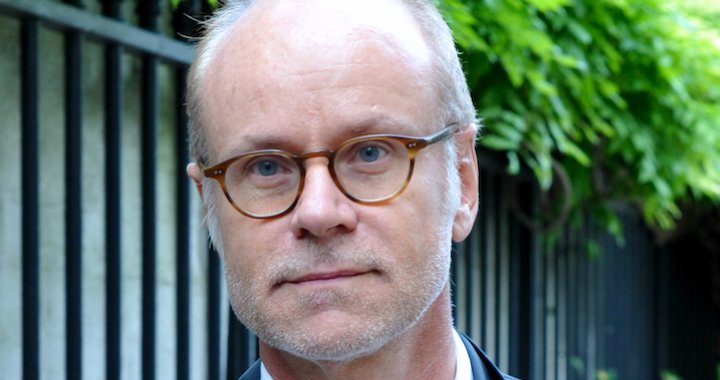
I live in my time
An interview with art collector Frédéric de Goldschmidt
18/04/2017
Frédéric de Goldschmidt, whose daily business is linked to the film industry, is currently one of the most prominent figures in Belgium’s art collecting scene. He was born and raised in Paris, where his grandmother – a painter and an art collector in her free time – regularly toted him along to the city’s art museums and galleries. However, when speaking about himself, Goldschmidt points out that even though art has always been in his life, he does not have a professional or formal background in art. Eventually he left Paris for Brussels, and now he can contentedly say: “I am happy to be in Brussels, where I feel a particular freedom, and where the art world feels more relaxed. Things happen here, and creativity can come out of chaos”.
Goldschmidt is a relatively new collector, considering that he acquired his first work of art in 2007. This piece was by Benjamin Sabatier, who is renowned for his charming ability to give new life to objects that have already served their primary purpose (e.g., old magazines), and to bestow a soul to odds and ends from daily life (e.g., rolls of colorful tape). Sabatier’s original aesthetic is a synthesis of a new kind of beauty and contemporary philosophy, one that is distinctly present in Goldschmidt’s flat in Brussels, which is where we chatted in early December of 2016. There, objects, centuries old, stand side by side with artworks that are clearly of the present day, and, strangely enough, they exist in a state of active dialog, thereby giving the space a truly unique aura. During our chat, Goldschmidt related that he’s not really familiar with Feng Shui, however, he does believe that art has a decisive role in generating the atmosphere of a space, and consequently, the way its inhabitants feel. Over the next hour and a half, at moments when Goldschmidt pauses to gather his thoughts, he visibly focuses his sight on a shelf on which “things come and go”, and on which, at present, sits a very old utilitarian vessel from Cambodia, and next to it, a contemporary objet d’art encased in a bottle by the young Belgian artist Benoit Platéus. The latter appeared on the shelf just the previous day. “They have been created with completely different objectives; one is recently made and the other is many centuries old, but they both have something in common...They both have an inner quality, and they are both signs of their times. And I have a feeling that the bottle will survive.”
The kickoff of Art Brussels in spring 2016 was accompanied by the opening of the exhibition Not really really, which presented a selection of 75 works from Goldschmidt’s collection. It was held in what was once a psychiatric clinic, and featured art in which functional objects and materials had been given totally disparate and alternative roles. According to the short version of the exhibition’s concept statement: “Removed from the material world, the objects have undergone various transformations to tackle a variety of subjects: car water containers blown in Murano glass, fans mounted on Belgian beer bottles, dishes cast in concrete, flattened silverware suspended in the air, and salt blocks shaped by donkey tongues dialogue playfully throughout four winding floors of a former mental health facility.” It is well known that one of Goldschmidt’s passions is art that has been made from unconventional materials. Although he admits that he is most interested in fostering creative art processes and supporting artists, he also emphasizes that the conservation of art – which is so very vital in the context of using uncommon materials – is becoming an increasingly relevant issue for both public institutions and private collections. In his opinion, this active engagement and dialogue is something that falls within the collector’s realm of responsibility, and during our talk he reiterated several times that in the new space for his collection (which is scheduled to open in late 2018), he will do everything possible to ensure that the artworks will be stored and displayed in an appropriate, controlled, and visitor-friendly environment.
An art professional once described Frédéric de Goldschmidt to me as an unpredictable collector. Goldschmidt attributes that particular characterization of himself to the fact that he doesn’t behave according to the established norms; but I can’t help but sense that there is something that he never says outright. It is simply there, in the ether – like the subtle relationship between the Cambodian vessel and a contemporary piece of art. The connection is there, but it is not palpable – there’s just a vague sense of its existence, but a knowing one. As we speak, the open and engaging demeanor of my conversational partner is lined with a kind of mystical secrecy. Perhaps that is why he is so taken with artworks that, using a metaphor from fairy tales, turn pumpkins into gilded coaches.
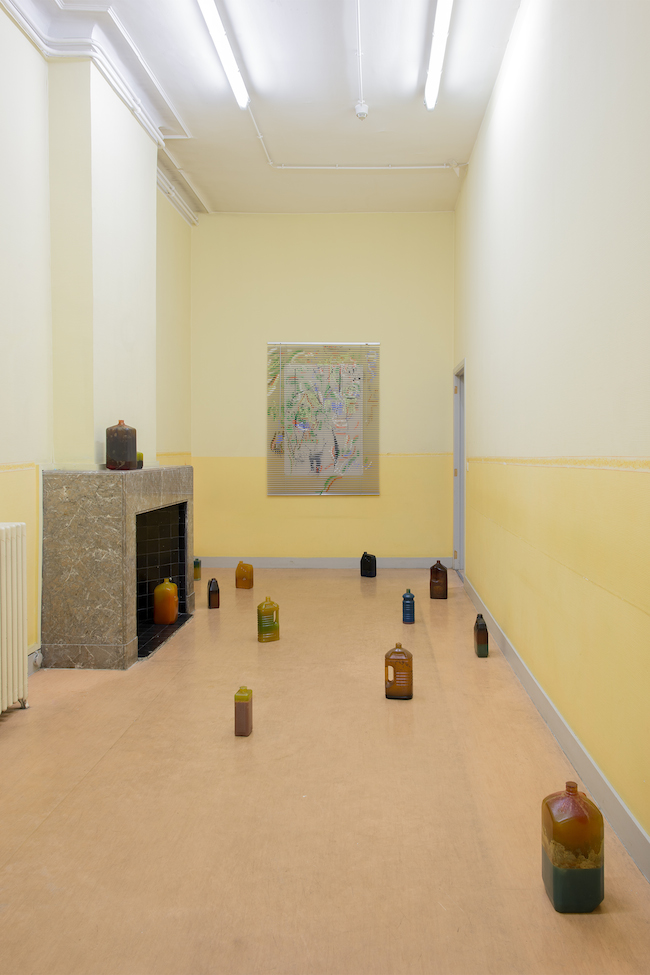
Benoit Plat.us. Jugs, 2016. Neil Haas. Paper David, 2014. Not Really Really exhibition view. Photo: Hugard & Vanoverschelde Photography
Someone once described you to me as “an unpredictable collector”. Why do you think you were characterized so, and how would you comment on that?
I may not seem unpredictable to myself, but I understand where this observation comes from. I guess I’m not driven by strict rules. For instance, I try to avoid acquiring artworks only according to particular schools or trends. I tend to be more attracted by, for instance, minimal than expressionist artists. I like certain styles more than others, but I don’t strictly adhere to any of them per say, and I don’t have an artistic background – in the sense that I have not studied art nor art history. Basically, I just follow my own instincts. I am attracted to what strikes me as interesting. It is possible that the person who described me as such was referring to the fact that, occasionally, I’m interested in phenomena that no one else is interested in. Things that are different, and which are not based upon any formal, scientific, or financial considerations. I’m simply attracted to works that speak to me – for whatever reason. Perhaps I don’t burden myself with over-thinking things.
What is it in art that speaks to you? Have you noticed any unifying elements in the things that you’re drawn to?
I believe that the art collector’s emotional reaction to the aesthetics of the work (unlike that of curators, critics, and viewers, who don’t have to live with the artwork in their personal environment) is decisively more important than its theoretical/conceptual framework – although both have to be linked in order to make a work attractive to a collector...so that the collector wants to have the work in his or her living room. It [the art], perhaps, shouldn’t be too challenging or esoteric in an artistic or aesthetic sense, although a bit of provocation is, of course, necessary because it makes the work better. At the same time, the collector would also want to know that the artist intended something beyond the pure material realization of the work. But the difference between a collector and an art lover is the fact that the former will have to live with this work for a long period of time, while the latter can make a passing judgment without having to commit to the artwork or concept. And this, of course, must be kept in mind. There is more gravity in collecting.
So, the notions of beauty and ugliness do carry weight in your life…
Beauty is not such an old-fashioned concept, and it should not be discarded. Today, the notion of beauty is simply being seen from a completely different point of view, and there’s another understanding of it than there was in the past. My aesthetic is “the aesthetics of little”; I am particularly sensitive to Arte Povera and to the Zero group. I was inspired by this kind of art. These works may not have been considered beautiful according to classical and traditional standards at the time, but they are beautiful in my eyes, in my understanding of things, and they continue to be. Right now, the aesthetics of the late 20th/early 21st century rule, and it contains values like constant changes and shocks. Perhaps someone will say that everything changes, and that after a while, the world will look at everything with completely different eyes. But that does not apply to me – because I live in my time, and my eyes have been influenced by my own history, and by the aesthetics of my time and the people who are around me. I am a part of my generation, and I follow the aesthetic trends of my time while always challenging myself to see differently and to uncover my own personal taste and aesthetic. Even if I don’t wish it to be so, and regardless of the fact that I may not be as predictable as the kind of collectors who buy the works of just a couple dozen of the most famous artists, collecting for me is very personal...like a dialogue that I have with myself...it is my way of seeing the world.

Benjamin Sabatier. IBK’s Scotch Tower III, 2007. Photo: Hugard & Vanoverschelde Photography
Benjamin Sabatier was the first artist whose work you bought, at FIAC…
Actually, his art concentrated within itself everything that we just spoke about. The first work by Sabatier that I ever saw was made from crumpled magazine pages stuffed into ice cube trays – an infinite number of trays filled with magazines. Supposedly, a very simple work. The fascinating thing about it, however, was that even though the magazines were cut up and wrinkled, they had not gone away – they were revealed in a new way; their shape was visible. It was a wonderful technique in which to reveal the beauty of recycling by creating a new aesthetic – from elements that, in themselves, are ugly, and that have never been seen as something from which one could create something beautiful. The result was, I believe, wonderful.
You’ve spoken much about the responsibility of the collector. What does that mean in today’s art world – in which so much power is wielded by money and, let’s say, those fifty famous names?
My interests are not linked to these fifty artists with big names. That’s not what I love, and it doesn’t excite me. I’m much more interested in supporting artists who are in the creative process, in helping them in the making of art. Even if, in the end, they never become as successful as the fifty top artists. Of course, in the back of my mind, I like to imagine that in the future, a few of them might be recognized for their work, gain greater fame, and become prominent artists. Arterritory.com has interviewed Alain Servais, who once told me that by selling just one piece from his collection, he managed to gain back 80% of everything he had invested in the collection. Of course, if one or two of the artists who I now support, and whose works I buy at relatively low prices, become very famous in ten or twenty years, why shouldn’t I decide to sell? By doing that, I will help others – at no cost. This one artist, by becoming famous, may help hundreds to continue making work.
The other field of responsibility of a collector, which I am actively focused on now, is, in my understanding, based upon the wish to present and preserve art so that it can be appreciated both by people today and also future generations. That’s not a simple thing to do if one hasn’t developed a well-organized system. And I’m not all that well organized, as you can see, since I have art placed in the corners of the room. That’s not really the best way to store it. This is a nice to place to live, but it’s not a space in which to enjoy and view art. When I buy an artwork, I like to unpack it; I want to show it to others and I also want to live with it. In my new home, I’m going to have a lot of walls. And it will have an excellent art storage space that will make the works more accessible and easy to review. Art will no longer be kept in boxes. I will be able to look at it and to show it at any moment. One doesn’t buy art to have it hidden away for the rest of your life; it doesn’t make sense if you can’t take advantage of it. Right now I’m doing everything I can to ensure that the new home for the artworks will be a safe storage solution, with the right temperature, etc.
This seems especially crucial in the context of your collection, considering that a large part of it consists of works that could be called “mortal” – as opposed to, for instance, the “immortality” of paintings.
Yes, that’s correct. I don’t have many paintings and I am not afraid of materials not ‘proven’ by time; this hasn’t been a conscious decision. First, I do think that painting is a great medium. When I visit art museums, I usually always start with the 17th-century Dutch painters. Second, I collect to support creation. But it may also be due to the fact that I’m a relatively new collector and that I unwittingly follow trends. Painting has made a big comeback since I started collecting in 2008, but back then it wasn’t in the forefront in the eyes of the critics and curators. Artists and collectors are the witnesses of their times. Whether they admit it or not, they depend on the materials available, on the feedback of their peers, on the directions curators give. I probably didn’t pay enough attention to the mortality of the works since I was more concerned with the immediate satisfaction I was receiving.
I now realize that preservation is a vital issue. Works that are made from plastics and paper age much faster than traditional painting; I know that. But now I am paying more attention to all of this as compared to when I first started collecting. I wish to support the creative process itself. I’m not quite as interested in what is going to happen to these works in the far future as I am with what takes place in the artist’s studio. I understand that there’s a contradiction happening here, since I speak about these two responsibilities myself, but that’s how things happen sometimes.
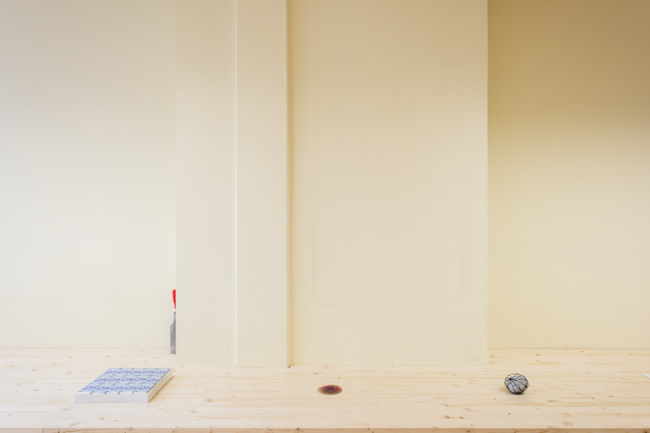
Jan Henderikse. Untitled, 2003. Oscar Tuazon. Hammer, 2014. Hayley A. Silverman. Crude Currencies Singular (the real price of everything / what everything really costs / to whom wants to acquire it / coin currencies (Chinese, Greek, Swedish, Canadian, Israeli, Russian…), energy currencies (lumps of metal, rice, spices, bee pollen, berries), 2015. Rein Dufait. Untitled, 2014. Not Really Really exhibition view. Photo: Hugard & Vanoverschelde Photography
You are excited about the collecting process itself…
Yes, I really do enjoy it. There are collectors who are much more passionate and obsessed than I am – like those who collect video art and performances, for example. They buy something absolutely non-material, something that requires huge effort in preserving the work, and a huge effort in the demonstration and exhibition process. If you collect performances, you also have to be driven to present them. On the last day of the exhibition “Not really, really”, I invited some artists to show a performance. I paid them a small fee, but I did not acquire the performance. I’m still a few steps behind the collectors who do so. A while ago I went toured the collection of a wonderful pair of collectors from Marseille – Josée and Marc Gensollen. They have a Tino Sehgal performance in their collection. When they open their collection to the public, one of them performs the work. It becomes like organizing a theater production. Perhaps all of that is in my future – once I open my new art space.
Did you enjoy the Tino Sehgal exhibition in Paris last autumn?
Tino Sehgal is a wonderful performance artist. The way he expresses his ideas, and at the same time, he gives everyone who is involved – both the participants and the audience – the opportunity to create something new, is absolutely fascinating. I’ve always been interested in the relationship between the artwork and the viewer, and I find this synergy so powerful because we all are so unique with our different senses, perceptions, interpretations, etc.
Do you believe that artworks give off an energy field?
When you move into an empty apartment or building, the space might be beautiful, but there’s something missing. Once you place an artwork, the atmosphere of the space changes immediately. I don’t know how it works, but it does. And some pieces work together – or not. It is, therefore, important to carefully select which artworks you will put in your home and where you place them. Because each one can have very diverse characteristics, even energy fields, maybe. Often times, you can’t move the piece that you have in your living room into your bedroom – because the effect will be totally different.
One of the reasons, subconscious or not, why collectors even collect and wish to have art in their proximity, may be to retrieve this energy that the artist has put in and that the work transmits.
I also know collectors who don’t wish to live together with the art that they own…
That’s the case with the very famous Belgian collector Herman Daled*, who collected conceptualism and minimalism in the 60s and 70s. He has never displayed any art from his collection in his house. The relationship that he has with his house is quite particular – the house was built in the same year as his birth, and he wishes to see this house grow old in the same way that he grows old. I believe that basically, Daled doesn’t want any kind of interventions in his relationship with this house. He has always had very intense relationships with art and the art world, but all existing outside of his private sphere.
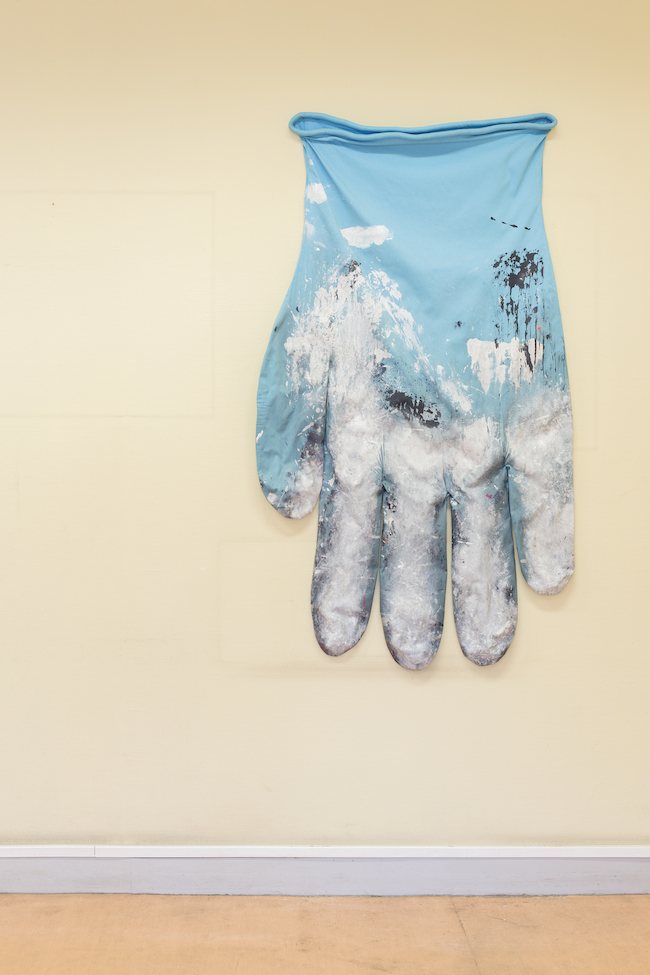
Amanda Ross-Ho. Blue Glove Right No. 2, 2014. Not Really Really exhibition view. Photo: Hugard & Vanoverschelde Photography
In the 20th century, the driving force behind art processes was composed of avant-garde phenomena, movements and manifestos – things that aren’t an active part of the 21st-century art scene. Finding yourself in the position of being a collector in today’s contemporary art world, have you gained an understanding of which direction today’s art is heading in, and does the collector have any influence in choosing this direction?
What a complex question… Truthfully, I probably don’t know in what direction the art world is headed in. I can’t predict it, so I have much pleasure in being a part of it and its evolution. It’s impossible to tell what, in five or ten years’ time, will be announced as having been the avant-garde of 2016. We can have a sense and intuition, but no knowledge that can be publicly seen or spotted. In my opinion, people simply aren’t able to spot what may be tomorrow’s avant-garde with any sureness. This could seem paradoxical at a time when the Internet and technology rule the world, and you can show practically anything to almost everyone in the world, and with immediacy… However, there are people who do not wish to use all of these opportunities, people who prefer a more analog approach. Admittedly, it may be much harder for them to gain recognition in the future. If you’re not in the right place today, it seems that you won’t be a part of the future, either…
It’s interesting to link this issue with the theme of the collector’s responsibilities and duties. Who guides the collector? The signs that he or she leaves (or doesn’t leave) behind in the world are what will dictate how the next generations view the artist’s accomplishments. Of course, a collector definitely has influence over art processes – in supporting artists, the collector rewards and promotes their achievements, at least in the short term. I don’t know exactly how it applies and contributes to the long term… I thought about this situation when visiting the Shchukin Collection exhibition at the Foundation Louis Vuitton in Paris this past autumn. What would things be like had Matisse not met the rich Russian collector…? And vice versa. How did they interact then? How did their destinies become entwined for posterity?
But are the artists who have gained the most recognition today really the best ones? What is it that allows it to be said that an artwork is either good or bad?
For me, good art combines a good concept and the adequate skills to make it work. But who am I to judge the quality of a concept and its realization? Only the future will really tell if it is good art or bad art. And then, for how long? The present is often made up of trends and fashions, but it will be the same in the future. Suddenly, people like things that were popular, for instance, twenty years ago; but they’re completely indifferent to everything that happened ten years ago. It’s like a wave – suddenly everyone loves it, and then everyone hates it. And it’s impossible to avoid this phenomenon. Of course, there are unique artworks that are not dependent upon any trends; and it is important to be able to feel these out, and to recognize them.
For a collector of contemporary art, it is essential to constantly visit fine art museums and to look at the art of previous generations. And to try and compare it to today’s manifestations; to look for the qualities around today which, perhaps, will be able to survive and add something to the larger conversation.
Today we see the tendency that everyone likes one and the same thing. There is an equalization of taste. And probably, also a reluctance to stand apart and maintain one’s own feelings and opinion. I think it’s much harder to stand apart today – both from the artist’s and the collector’s point of view. It is demonstrably harder to go against the flow and to resist trends now than in the previous century; back then, there were numerous different paths and tendencies. Now, that room has become much narrower.
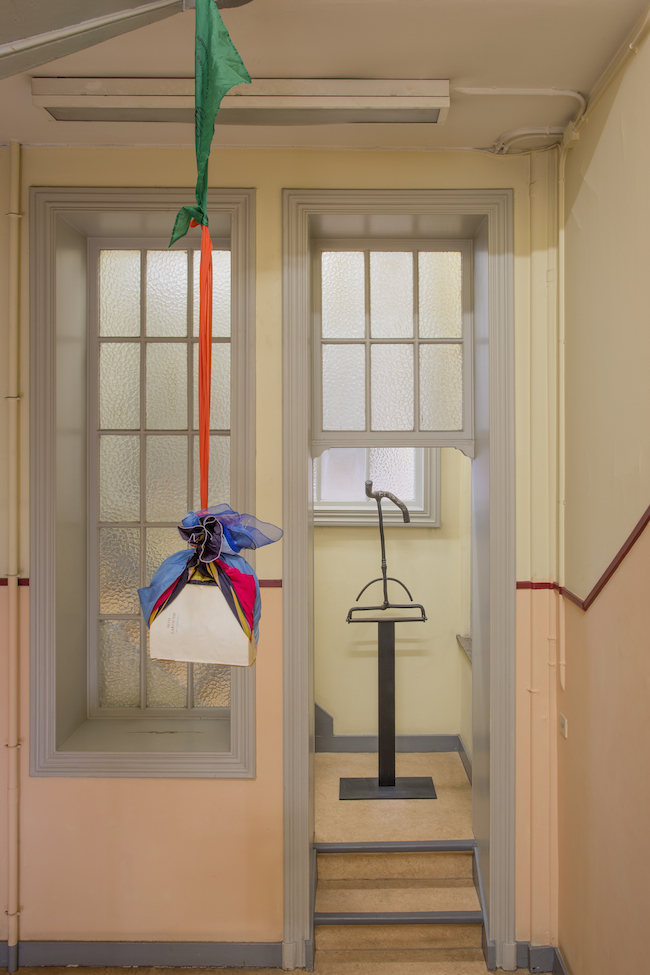
Juan Pablo Plazas. La Rousse, 2015. Camille Henrot. Fiat Panda 1980–2003 (from Endangered Species series). Photo: Hugard & Vanoverschelde Photography
In an interview with Arterritory.com, the Latvian-American painter Raimonds Staprāns said that he prefers relationships with writers because, unlike artists, their minds are better organized. Artists don’t need a brain – they need talent. In contemporary art, how essential do you think a phenomenon like talent is?
I think that there are two kinds of talent. One is what could be called a talent for conceptual thinking. The ability to find an idea that is appropriate for the situation in which the artist finds him- or herself, and which also means something to at least one viewer (with the hope of there being more). This is what separates an artist from, for example, someone in the mainstream film industry who does not have the luxury of creating something that less than several hundreds of thousands of viewers will enjoy.
The other kind of talent is the ability to create an artwork that is excellent – regardless if those are his or her hands physically making it, or if the artist has to ask someone else for help in giving the work its finish or genius stroke. Of course, I like the fact that an artist’s hand can be recognized in a detail, in a painting – when there is something there that no one else could do, and which will stand the test of time. I like all of that. However, I also think just as highly of artworks in which the artist, realizing that he or she does not have the specific technical skills, finds someone who does have these skills, and uses their services so that the work can be executed – it is still driven by the artist’s own concept and sensibility.
Returning to the comparing of artists and writers… Of course, writers have to do everything themselves, and it is a markedly private and individual ability. Today an artist can, however, work with a team of technical assistants. We like to picture Michelangelo painting the Sistine Chapel and hurting his back, but he had assistants. The phenomenon is not new. It’s like in film: the producer and the director are at the beginning of the creative process, yet they largely depend on the talents of others to create something that is unique and special. That’s why I wholeheartedly respect the fact that an artist can have assistants, and that they can make agreements with others in order to realize an idea that was improved by the added value of their collaborators.
Do you have relationships with artists? Is their personal story behind their art important to you?
That’s difficult to answer. In 90 percent of cases, my reaction and perspective is dependent purely upon the art itself, and my experience of seeing and understanding the work. I do not have the need to know what the artist was thinking, and that’s why I don’t necessarily feel the need to meet them. Occasionally, it will make the work more interesting; although, there have been instances when – and I know it may sound strange – the story behind the artwork doesn’t fit with what I had imagined myself, and then it’s a disappointment. Or, I stick with my original idea…
Nevertheless, I like to meet with artists and to be a part of the greater art society. In Brussels this is really easy, and I enjoy it – I invite artists to my home, galleries organize dinners, there are various informal get-togethers, etc. If, in most cases, artists are indeed more interesting than your average neighbor, the wish to meet artists and the enjoyment of their company cannot be equivalent to the enjoyment that comes from their art.
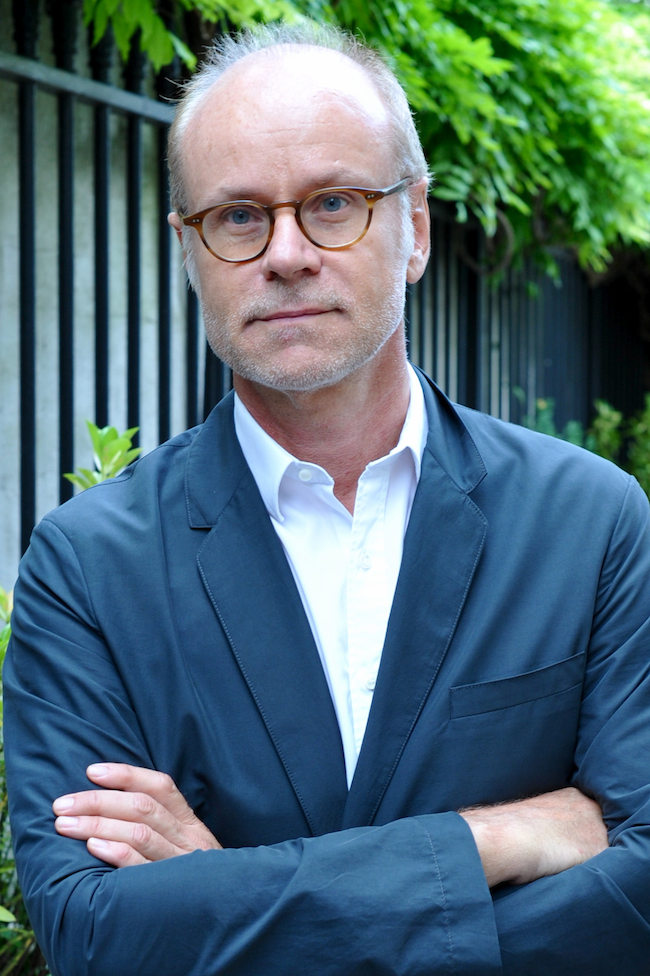
Frédéric de Goldschmidt. Photo: Ronald Martinez
You relocated from Paris to Brussels. Why is that?
In various places, cities, and institutions around the world, the communication that takes place between the art and the viewer is different and reflects something about the unique character of its particular place and culture. I’m happy to be in Brussels, where I am very free to do what I do, and the way that I do it. This is a place where smaller institutions and art spaces dominate, and where the viewer can be in much closer contact with the art scene’s pulse than in bigger cities such as Paris, New York, London, etc. The fact that the local art scene is smaller also brings the art professionals closer to one another – the gallerists, collectors, curators and artists interact and exchange ideas. Except for a couple of exceptions, there aren’t mega-galleries like in Chelsea, NYC. There they have to commission large-format works for large-format names, because they can’t do it any other way. They must pay high rents and they have to pay the wages of the many people who work there to keep everything going. And that’s why art has to be sold – every month a pile of money has to come in to keep the art machine going. It’s all part of the system. Whereas in Brussels, real estate is cheap, and you can get by and make things happen with a much smaller amount of money than in New York. This, perhaps, allows for more room for experimental and cutting-edge art. Art institutions live their lives in Brussels in much better spirits because they know that they will survive, and that even with a small budget, they can present their point of view.
This may change with the large contemporary art museum being developed in association with the Pompidou Centre. It should open some time around 2020; I believe that the impact on the local art community should be good. I am particularly happy that this is less than 300 meters away from where my collection will be on view.
My concept is not as ambitious, of course. It will consist of shared office spaces, apartments (including my own), storage facilities, and exhibition spaces that will be used for my collection and also for temporary shows. It will be based on a self-sustaining system in which the goal is make both ends meet symbiotically. One could say that the hope is to sustain a balanced system, one in which the money that the office space generates can allow artists or curators to live and work there, as well as fund the production of exhibitions that will feature emerging artists from different disciplines.
*Herman Daled is one of the most significant Belgian art collectors, a close friend and supporter of many conceptual artists, and together with his wife, Nicole Daled-Verstraeten, owned one of the greatest and most complete collections of conceptual art. In 2011, the larger part of it was sold to the MoMA in New York.